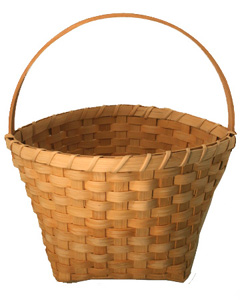Pricing Your Baskets
Pricing Your Baskets (from www.basketweaving.com)
Pricing your baskets is a complicated process and people do it different ways. The information provided here is meant to serve as a basic guideline to remind you of general pricing factors.
First is the cost of materials. The reed or splint, the handle, anything you add to the basket (tie-on’s, labels, other decorations or trims) and stain or finishing supplies. Before you weave the basket, be sure to weigh your handle separately so that you know the weight of, for example, a 10×12 D handle. Record it in a notebook so that you don’t have to keep re-weighing the same size.
Then weigh the finished basket while it’s dry. Subtract the weight of the handle. The remaining weight needs to be multiplied by the cost of the reed. 1/2 pound basket times $10.95 for reed equals $5.475 for the reed. Add the cost of the handle and other items, plus the cost of staining the basket. (Divide the cost of a can of stain by the number of baskets that you stain with one can.)
Next, add your labor cost. Multiply your number of hours worked by a reasonable hourly wage. What’s reasonable?
This depends on where you live and whether your market area has other basket competition.
Beginning weavers should charge at least a couple of dollars per hour above minimum wage. Experienced weavers (5-10 years+) should charge more of a “craftsman’s” hourly wage- similar to cabinet makers and other fine crafts. We hesitate to name dollar amounts in any case because of the tremendous variation from state to state and country to country. You need to determine your hourly wage based on what the market will bear in your area. Some areas have more respect for basketry as a truly distinctive craft. Experienced weavers will eventually create a name for themselves and establish their personal style of weaving- a special style of dyeing, a special technique like unique market baskets or antler baskets or natural fiber baskets. These factors add value and distinction to the basket.
Once you have a record of sales, be sure that you’re writing down the basket type, size and price sold. You’ll quickly see a pattern that establishes which baskets are moving faster than others.
Finally, there are the costs of doing business. Booth rental, table rental, vehicle expenses (Gas!), advertising, etc.
Pricing Your Baskets




